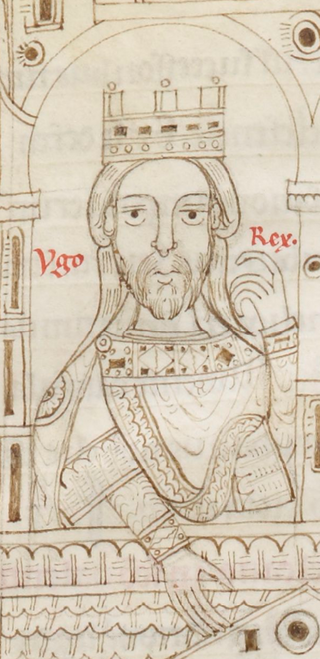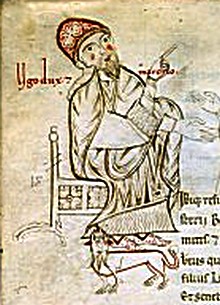
The Duchy of Spoleto was a Lombard territory founded about 570 in central Italy by the Lombard dux Faroald. Its capital was the city of Spoleto.

Hugh, known as Hugh of Arles or Hugh of Provence, was the king of Italy from 926 until his death. He belonged to the Bosonid family. During his reign, he empowered his relatives at the expense of the aristocracy and tried to establish a relationship with the Byzantine Empire. He had success in defending the realm from external enemies, but his domestic habits and policies created many internal foes and he was removed from power before his death.

Berengar I was the king of Italy from 887. He was Holy Roman Emperor between 915 and his death in 924. He is usually known as Berengar of Friuli, since he ruled the March of Friuli from 874 until at least 890, but he had lost control of the region by 896.
The Battle of Garigliano was fought in 915 between Christian forces and the Saracens. Pope John X personally led the Christian forces into battle. The aim was to destroy the Arab fortress on the Garigliano River, which had threatened central Italy and the outskirts of Rome for nearly 30 years.

Farfa Abbey is a territorial abbey in northern Lazio, central Italy. In the Middle Ages it was one of the richest and most famous abbeys in Italy. It belongs to the Benedictine Order and is located about 60 km (37 mi) from Rome, in the commune of Fara Sabina, of which it is also a hamlet.
Adalbert II, called the Rich, son of Adalbert I, Margrave of Tuscany and Rothild of Spoleto. He was a grandson of Boniface II, and was concerned with the troubles of Lombardy, at a time when so many princes were contending for the wreckage of the Carolingian Empire. Before his father died in 884 or 886, he is accredited the title of "count". He inherited from his father the titles of Count and Duke of Lucca and Margrave of Tuscany.
Boso was a Burgundian nobleman who spent much of his career in Italy, where he became Margrave of Tuscany about 932. He ruled semi-autonomously and was a benefactor of the churches of his region. He lost his office in 936 and probably returned to Burgundy.
Hubert was the illegitimate son of King Hugh of Italy and his concubine Wandelmoda. He became Margrave of Tuscany in 936 and Duke of Spoleto and Margrave of Camerino in 943.

Hugh, called the Great, was the Margrave of Tuscany from 969 until his death in 1001, and the Duke of Spoleto and Margrave of Camerino from 989 to 996. He was known for his restoration of the state apparatus in Tuscany after decades of neglect from various Margraves, whose main interests lay elsewhere. Hugh was also noted for his support of the new Ottonian dynasty, and has been praised for his justice by the contemporary theologian Peter Damian in his De principis officio. Hugh's rule has also been remembered for its close cooperation with the Papal States in the resolution of territorial disputes and his generosity in gifting marchesal (public) lands for the foundation of monasteries of the Catholic Church.
Adalbert I was the margrave of Ivrea, the second of the Anscarid dynasty, from the late 890s until his death. In the intermittent civil war which affected Italy from 888 into the 930s, Adalbert initially strove to remain neutral, but from 901 on he sided sequentially with every claimant to the Italian throne.
Ulric Manfred II or Manfred Ulric was the count of Turin and marquis of Susa in the early 11th century. He was the last male margrave from the Arduinid dynasty. Ulric Manfred's daughter, Adelaide, inherited the majority of his property. Through marriage to Adelaide, Otto of Savoy, a younger son of Count Humbert I of Savoy became margrave of Turin. Their descendants would later comprise the House of Savoy who ruled Sardinia and Italy.
Arduin Glaber was count of Auriate from c. 935, count of Turin from c. 941/942, and Margrave of Turin from c. 950/964. He placed his dynasty, the Arduinici, on a firm foundation and established the march of Turin through conquests and royal concessions. The Chronicon Novaliciense, the chronicle of the abbey of Novalesa, is the primary source for his life.
Manfred I or Maginfred was the second Arduinici marquis of Susa from 977 until his death. Manfred was the eldest son of Arduin Glaber, from whom he inherited the county of Auriate and the vast March of Susa. The march extended from the Susa Valley by the Alps south across the Po to the Ligurian Sea. Although he ruled for almost twenty-five years, there is little evidence of his activities in surviving sources. Under him, Pavia became a mercantile city. He also controlled the road between Genoa and Marseilles.
Adelaide of Turin was the countess of part of the March of Ivrea and the marchioness of Turin in Northwestern Italy from 1034 to her death. She was the last of the Arduinici. She is sometimes compared to her second cousin, and close contemporary, Matilda of Tuscany.
Bertila of Spoleto was the wife of Berengar I of Italy, and by marriage Queen consort of Italy and Holy Roman Empress.
Anscar was a magnate in the Kingdom of Italy who served as Count of Pavia, Margrave of Ivrea (929–36) and Duke of Spoleto (936–40). He is sometimes numbered "Anscar II" to distinguish him from his grandfather, Anscar I of Ivrea. Described by Liutprand of Cremona as courageous and impulsive, he died in the battle of Spoleto.
The Battle of Spoleto took place in 940 between the forces of the count of the palace Sarlio and those of Duke Anscar of Spoleto. Sarlio had been paid by King Hugh to cause unrest in Spoleto, to give cause for the removal of Anscar. Liutprand of Cremona is the only source for the battle and he specifies neither the day nor the place.
Ermengarde of Tuscany was a medieval Italian noblewoman. She was the daughter of Bertha of Lotharingia and Adalbert II, Margrave of Tuscany. She was countess of Ivrea through marriage to Adalbert I of Ivrea. Alongside her half-brother Hugh of Italy Ermengarde was an important opponent of Rudolf II of Burgundy’s rule in Italy.
Willa of Burgundy was a member of the Elder House of Welf. By birth she was a daughter of Rudolph I of Burgundy, king of Upper Burgundy. Through marriage Boso Willa became countess of Avignon and Arles, and then margravine of Tuscany.
Willa of Spoleto was the daughter of Boniface I, duke of Spoleto. Through marriage to Hubert, Duke of Spoleto Willa became duchess of Spoleto and margravine of Tuscany.